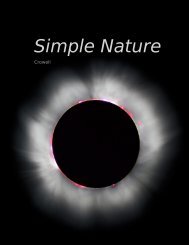Chapter 1 Conservation of Mass - Light and Matter
Chapter 1 Conservation of Mass - Light and Matter
Chapter 1 Conservation of Mass - Light and Matter
You also want an ePaper? Increase the reach of your titles
YUMPU automatically turns print PDFs into web optimized ePapers that Google loves.
i / Two balls start from rest,<br />
<strong>and</strong> roll from A to B by different<br />
paths.<br />
field. If the plane can start from 10 km up, what is the maximum<br />
amount <strong>of</strong> time for which the dive can last?<br />
⊲ Based on data about acceleration <strong>and</strong> distance, we want to<br />
find time. Acceleration is the second derivative <strong>of</strong> distance, so if<br />
we integrate the acceleration twice with respect to time, we can<br />
find how position relates to time. For convenience, let’s pick a<br />
coordinate system in which the positive y axis is down, so a=g<br />
instead <strong>of</strong> −g.<br />
a = g<br />
84 <strong>Chapter</strong> 2 <strong>Conservation</strong> <strong>of</strong> Energy<br />
v = gt + constant (integrating)<br />
= gt (starts from rest)<br />
y = 1<br />
2 gt2 + constant (integrating again)<br />
Choosing our coordinate system to have y = 0 at t = 0, we can<br />
make the second constant <strong>of</strong> integration equal zero as well, so<br />
�<br />
2y<br />
t =<br />
g<br />
�<br />
2 · 10000 m<br />
=<br />
10 m/s 2<br />
�<br />
= 2000 s 2<br />
= 40 s (to one sig. fig.)<br />
Note that if we hadn’t converted the altitude to units <strong>of</strong> meters,<br />
we would have gotten the wrong answer, but we would have been<br />
alerted to the problem because the units inside the square root<br />
wouldn’t have come out to be s 2 . In general, it’s a good idea to<br />
convert all your data into SI (meter-kilogram-second) units before<br />
you do anything with them.<br />
High road, low road example 9<br />
⊲ In figure i, what can you say based on conservation <strong>of</strong> energy<br />
about the speeds <strong>of</strong> the balls when the reach point B? What does<br />
conservation <strong>of</strong> energy tell you about which ball will get there<br />
first? Assume friction doesn’t convert any mechanical energy to<br />
heat or sound energy.<br />
⊲ Since friction is assumed to be negligible, there are only two<br />
forms <strong>of</strong> energy involved: kinetic <strong>and</strong> gravitational. Since both<br />
balls start from rest, <strong>and</strong> both lose the same amount <strong>of</strong> gravitational<br />
energy, they must have the same kinetic energy at the<br />
end, <strong>and</strong> therefore they’re rolling at the same speed when they<br />
reach B. (A subtle point is that the balls have kinetic energy both<br />
because they’re moving through space <strong>and</strong> because they’re spinning<br />
as they roll. These two types <strong>of</strong> energy must be in fixed














